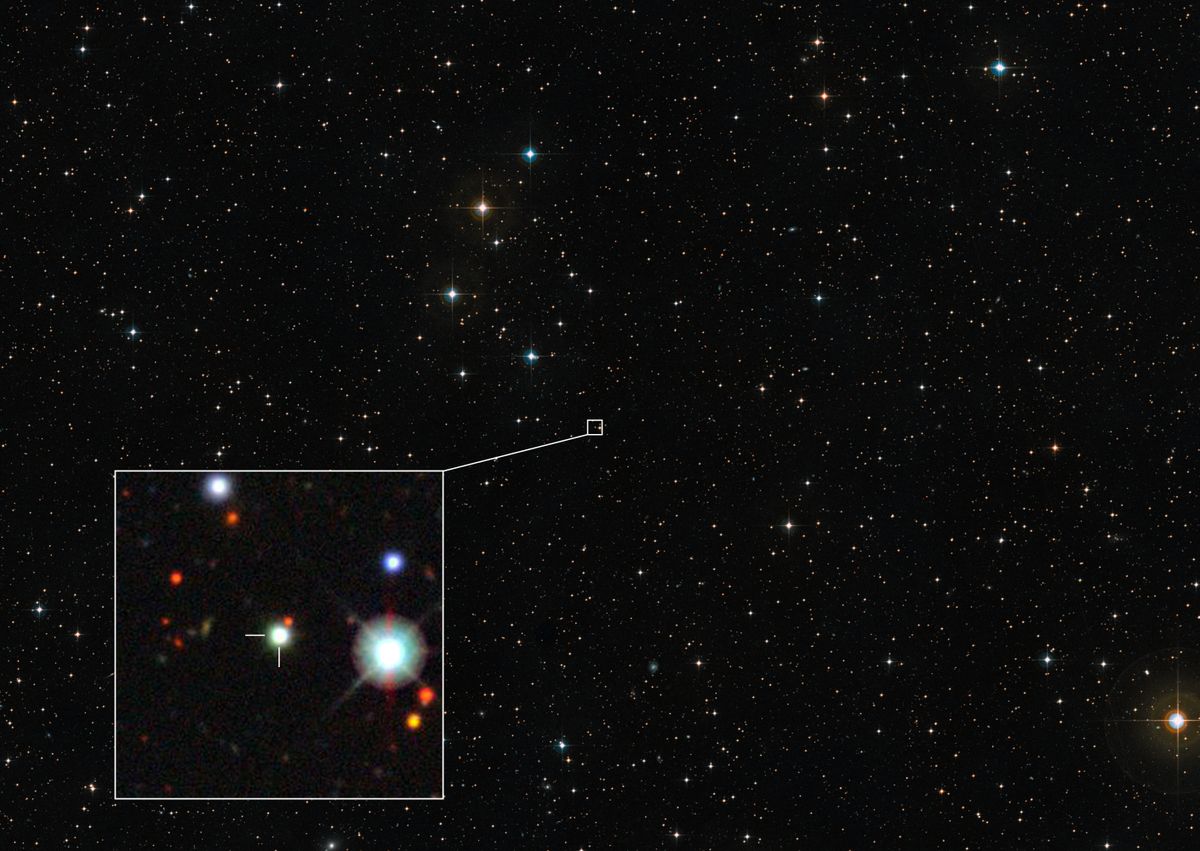
Scientist discover brightest quasar with black hole in its center that "eats" matter equal to mass of Sun every day
A recently discovered quasar has set remarkable records. It not only holds the title of the brightest quasar ever observed but also stands as the brightest celestial object ever recorded. What adds to its uniqueness is the presence of the most voracious and fastest-growing black hole ever identified, devouring the equivalent of over one solar mass each day.
Known as J0529-4351, this quasar resides so distant from Earth that its light has traveled for 12 billion years to reach us. Consequently, we observe it as it appeared when the universe was just under 2 billion years old in its 13.8 billion-year existence.
At the heart of J0529-4351 lies a supermassive black hole estimated to weigh between 17 billion and 19 billion times the mass of the sun. Annually, this colossal black hole accretes gas and dust equivalent to 370 solar masses, rendering J0529-4351 so brilliantly luminous that if placed beside the sun, it would outshine our brilliant star by 500 trillion times.
Christian Wolf, the team leader and an astronomer at the Australian National University, remarked, "We have discovered the fastest-growing black hole known to date. It has a mass of 17 billion suns and eats just over a sun per day. This makes it the most luminous object in the known universe."
Despite being detected in data over four decades ago, J0529-4351 was so dazzling that astronomers initially overlooked it as a quasar.
How a quasar has baffled astronomers for 44 years?
Quasars, located at the cores of galaxies, harbor supermassive black holes surrounded by gas and dust that fuel these cosmic voids. The intense conditions in the accretion disks, generated by the immense gravity of active black holes, cause the material to glow brightly. J0529-4351, with its massive accretion disk estimated to have a diameter of around 7 light-years, surpasses typical quasars in brightness.

The surprise of its discovery is highlighted by Christopher Onken, a team member and scientist at the Australian National University, who stated, "It is a surprise that it has remained unknown until today when we already know about a million less impressive quasars. It has literally been staring us in the face until now."
Initially identified in the Schmidt Southern Sky Survey from 1980, it took decades to confirm J0529-4351 as a quasar, emphasizing the need for machine-learning models to analyze vast astronomical survey data and distinguish quasars from other celestial entities.
These models are trained with data from currently known celestial objects, which can result in overlooking candidates possessing exceptional properties, such as J0529-4351. This remarkably bright quasar was initially dismissed as a star in close proximity to Earth due to the model's oversight.
When and how did they realize it was a quasar?
The error came to light in 2023 when astronomers reexamined the object's region using the 2.3-meter telescope at the Siding Spring Observatory in Australia. Subsequent confirmation of J0529-4351 as a quasar occurred when the X-shooter spectrograph instrument on the Very Large Telescope (VLT) in the Atacama Desert of Northern Chile investigated the object, revealing it to be the brightest quasar ever discovered.

Astronomers are not concluding their study of J0529-4351. The team believes that the supermassive black hole at the core of this quasar is operating near the Eddington limit, potentially reaching the point where radiation should repel gas and dust, limiting the black hole's cosmic consumption. Further confirmation of this hypothesis will necessitate a more in-depth investigation.
The upgraded GRAVITY + instrument at the VLT, designed to enhance high-contrast precision on bright objects, is considered ideal for studying the voracious supermassive black hole in J0529-4351. Additionally, the upcoming Extremely Large Telescope (ELT), currently under construction in the Atacama Desert, will contribute to the investigation of this intriguing celestial phenomenon.
The leader of the team driving this groundbreaking discovery finds motivation in the excitement of discovering something new. Christian Wolf expressed, "Personally, I simply like the chase. For a few minutes a day, I get to feel like a child again, playing treasure hunt, and now I bring everything to the table that I have learned since." The team's research, detailing their findings, was published in the journal Nature Astronomy on Monday, February 19.
- Related News
- Perseverance finds rock on Mars with signs of life on Earth (photo)
- On 25th anniversary of Chandra telescope, NASA released 25 photos previously unseen by the public
- Rare intermediate-mass black hole has been discovered at the center of our galaxy
- Stone "snowman" and pure sulfur crystals on Mars։ Remarkable discoveries by Perseverance and Curiosity
- When will humanity settle on Mars? Interview with Gernot Grömer
- TESS telescope discovers super-hot exoplanet the size of Neptune
- Most read
month
week
day
- Buyers massively complain about Samsung's Galaxy Buds 3 and Buds 3 Pro headphone, even finding hair in the box 820
- With today's mortgage interest rates, banks simply cannot sell products in 2025: Interview with Vardan Marutyan 811
- Ants and bees 'taught' tiny drones to navigate without GPS, beacons or lidars 675
- Samsung will release Galaxy Tab S10+ and Ultra tablets and Galaxy Z Fold 6 Slim and Galaxy w25 smartphones in October 640
- Mass production of iPhone SE 4 will begin this October, with sales starting in 2025 599
- Insider unveils specs of all smartphones of iPhone 17 series, including the 17 Slim 595
- Telegram's monthly active audience reaches 950 million 585
- What dangers can feature phones from unknown manufacturers conceal? 553
- For the first time in history, iPhone will get a Samsung camera 552
- Next iPhone SE may have powerful A18 chip and Apple Intelligence AI functions 546
- Archive
